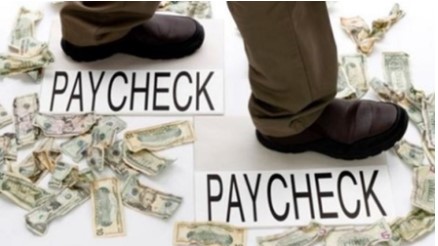
About 36 percent of Americans earning at least $250,000 a year claim that they are living paycheck to paycheck, a sign on how rising inflation is hitting households at all ends of the spectrum throughout the country, according to two surveys quoted by Bloomberg.
Individuals earning $250,000, who are among the top 5 percent of income earners, according to the U.S. Census Bureau, are spending most of their income on household expenses, according to the surveys by Pymnts.com and LendingClub.
Americans across all income brackets are currently facing the highest inflation rates since the early 1980s, which is hitting essential items like food and energy and is affecting lower income earners harder.
Bloomberg said that consumer borrowing in March soared to one of the highest on record, as credit card balances and non-revolving credit skyrocketed, a sign of increased consumer spending amid rising prices.
Only 10 to 12 percent of respondents earning over $100,000 who said they were living paycheck to paycheck had issues paying their bills, with the majority reporting that they were still comfortable.
LendingClub said that 48 percent of those earning at least $100,000 are beginning to struggle, an increase of 9 percent from the year before, with 61.3 percent or about 157 million of total American adults, admitting so in April.
“Earning a quarter of a million dollars a year is more than five times the national median and is clearly high income,” said Anuj Nayar, LendingClub’s Financial Health Officer.
“The fact that a third of them are living paycheck to paycheck should surprise you.”
The financial pain is particularly hitting Millennials, a generation now in their mid-20s and early 40s, who normally have little saved for retirement compared to their mostly retired Boomer parents.
The majority of top earners in that age cohort report spending most of their earnings by the end of the month.
Housing expenses such as mortgages, which have risen dramatically since the pandemic and the recent hike in the interest rate, are one of the main items eating up the budgets in the $250,000 and above income bracket, according to the survey.
Higher-income households are also more likely to put their expenses on credit cards compared to other income brackets and tend to pay off their balance in full.
LendingClub said that living paycheck-to-paycheck did not necessarily mean actual hardship, as the survey made a clear distinction between those who could or were not able to pay their bills.
Study participants were divided between whether they were getting by “with difficulty” or if they were “comfortable.”
How families deal with rising costs is relative, with 19 percent of middle income respondents earning $50,000 to $100,000 admitting they were struggling more, compared to the 36 percent of lower income respondents earning less than $50,000 claiming financial hardship at the end of the month.
Meanwhile, few high earners reported issues covering all of their household expenses, with only 10 percent reporting problems last month.